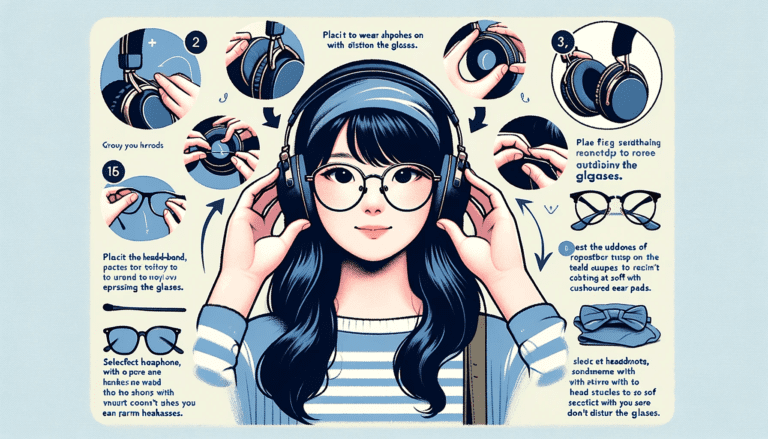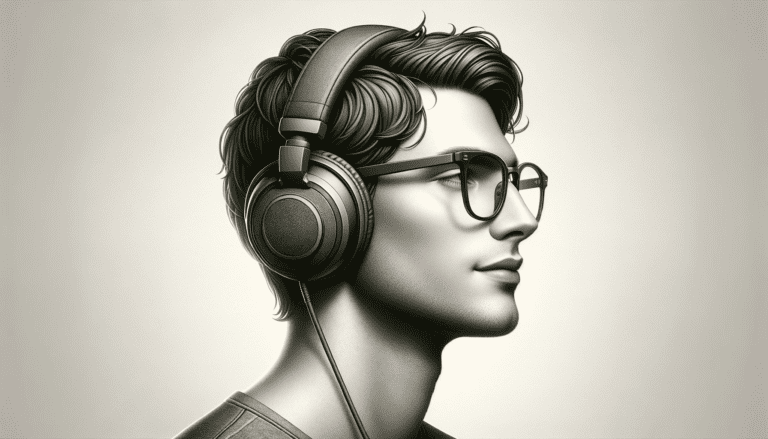Ever been stuck in traffic, your car stereo’s broken, and you’re dying to listen to your favorite podcast? You glance at your headphones, and wonder… “Can I drive with these on?
The answer might not be as simple as you think. Balancing between the legality, the safety implications, and the potential benefits, we’re about to explore the complex issue of driving with headphones on. So buckle up, turn down the volume, and keep your eyes on the road as we gear up for this journey.
Understanding the Basics: Is It Legal to Drive with Headphones On?
Are you wondering if it’s legal to drive with headphones on? Well, first and foremost, you need to remember that laws can vary widely from region to region. There’s not a one-size-fits-all answer to this question, but we’re here to give you some general insight to help you discern the answer.
Now, let’s lay down some fundamentals. In some states or countries, there are explicit laws prohibiting the use of headphones while driving. Yet, in others, there may be no explicit laws against it, but it could be considered as ‘driving without due attention or care’ or ‘reckless driving’, depending on the circumstances.
In general, it’s crucial to remember that traffic regulations are primarily in place to ensure everyone’s safety on the road. Even if there isn’t a specific rule against headphones, using them is a decision that should be made with awareness and consideration of its potential impact on your driving abilities.
The most sensible course of action would be to adhere to your local laws. If you’re not sure about the legality of using headphones while driving in your area, checking with your local Department of Motor Vehicles or law enforcement agency will clarify things. This will not only keep you compliant with the regulations, but also help you in ensuring your safety and the safety of others on the road.
Exploring the Safety Concerns: Driving with Headphones
When you slip on those headphones and turn up your favorite tunes, it feels like the most natural thing in the world. But is it safe? Many factors contribute to the dangers of driving with headphones, making it something to seriously reconsider.
Distractions:
The primary concern when mixing headphones and driving is distraction. Although you might think listening to your favorite playlist helps you concentrate, it can actually divert your attention from the road. Music, podcasts, or phone conversations can quickly consume your thoughts, preventing you from fully focusing on your surrounding environment.
Audio Isolation:
A good pair of headphones can block out external noise almost entirely, which means you might miss crucial audio cues. You may not hear a car honking, an ambulance siren, or a pedestrian shouting. These situations can lead to serious consequences, potentially putting you and others in danger.
Physical Impairment:
Wearing headphones while driving can make it more difficult to handle your vehicle properly. Things like adjusting your volume, changing songs, or untangling your headphone cables can cause you to take your hands off the wheel or your eyes off the road.
Let’s recall an important piece of advice your driving instructor likely shared with you: anything that distracts you from the primary task of driving should be avoided. When it comes to safety, it’s always better to err on the side of caution.
Remember:”Driving isn’t just about transporting yourself from point A to point B; it’s about doing so safely and responsibly.”
Headphone Laws for Drivers: A State-by-State Breakdown
Imagine this, you’re on a road trip, crossing state borders, bobbing your head along the tracks that sound better with your headphones on. But wait, is it legal? Just like you, many are unaware that driving with headphones laws vary from state to state in the U.S. Let’s break it down for you.
| State | Is Driving With Headphones Legal? |
|---|---|
| California | No |
| New York | No |
| Texas | Yes, but with stated limitations |
| Florida | Yes |
| Illinois | No |
| Ohio | Yes, but with stated limitations |
| Pennsylvania | Yes |
Note: This table is not exhaustive, and specific laws may vary within each state and potential updates happening over the years. Always check the local traffic regulations of any state you’re planning to drive.
For instance, in states like Texas and Ohio, where driving with headphones is partially allowed, the law prohibits blocking both ears — your stereo headphone is pushing it, but a single earbud could pass. The intention behind such limitations is to keep your ears open for emergency sirens, honking horns, or any other crucial audio cues.
On the contrary, states like California and New York speak more straightforwardly. Wearing headphones over both ears while driving is simply forbidden. This includes Bluetooth headsets, earbuds, and other audio devices.
If you’re caught driving with headphones in these states, you could face heavy fines and potential points on your driver’s license, also potentially hike up your insurance premiums.
“The sounds of daily life can serve as an important environmental cue to potential danger. When you limit your ability to hear what is happening outside your vehicle, you put yourself, pedestrians, and other drivers at risk.”
So next time before slipping on those headphones for that solo road trip, remember, ignorance of the law is no excuse. Be attentive, stay informed and exercise safety measures.
Reasons Why You Might Consider Using Headphones While Driving
While it might not seem immediately of benefit, there are indeed some scenarios where people consider using headphones while driving. Although it’s crucial to note that safety and legal implications make this decision one that should be taken with great caution. Let’s take a look at some of the reasons prompting this thought process.
- Improved audio quality: A driver may believe that headphones can provide better sound quality than their vehicle’s speaker system. Be it the crispness of acoustics, the pure bass experience, or complete immersion, headphones often offer a superior sound experience.
- Noise isolation: If a driver is in a louder setting, such as the bustling streets of a busy city, the noise isolation features of headphones could help shield them from unnecessary and distracting sounds. This aspect is particularly relevant if they’re consuming important content like an instructional audio guide or perhaps, news updates.
- Private phone calls: Some drivers may choose to use hands-free headphones to participate in private phone conversations, preserving the confidentiality that is otherwise lost in a standard speakerphone setting.
- GPS instructions: People who regularly depend on GPS directions might combine their mobile device with headphones, under the assumption they’ll hear instructions more clearly and not disturb other vehicle occupants.
In summary, while these points illustrate why some might opt for headphones, they do not supersede the need for safety or compliance with the law. Remember, whatever your reasons might be, driving with any potential distraction comes with significant risks—and potentially consequences.
The Impact of Headphones on Driver Awareness and Reaction Time
Driving with headphones can influence your road awareness and reaction time, two crucial variables when it comes to safe driving. Let’s break it down.
Driver Awareness:
Being aware of what’s unfolding on the road around you is pivotal for a motorist. Using headphones can insert a layer of sonic insulation, essentially reducing your awareness of the outside world. This disconnect can significantly impact your ability to anticipate and react to changes, whether it’s a stop sign that you hadn’t noticed, or an ambulance siren in the distance. Your headset might make your journey more enjoyable, but it may also limit your situational awareness, setting the stage for potential danger.
Reaction Time:
A key part of being an attentive motorist is possessing a rapid reaction time. Hearing is a significant factor in reacting quickly to unexpected circumstances. However, if you’re engrossed in music or a podcast, your auditory attention is divided, which could cause a delay in your response. A sudden horn, a cyclist darting out, even the screech of brakes – if your headphones are blocking these crucial audio cues, it might increase your reaction time, and ultimately, your chances of getting involved in an accident.
In essence, both road awareness and reaction time may be compromised when you drive with headphones. Remember, your responsibility as a driver is to ensure the safety of you, your passengers, and others on the road. The price of an enjoyable journey could be significantly more substantial than imagined if these factors are not considered.
Research further supports these points. A study involving participants using headphones during a driving simulation found that reaction times increased and awareness declined as compared to when they drove without headphones. So, whether it’s your favourite tune or an interesting podcast episode, remember to consider the potential impact on your driving safety.
Critical Note: Remember, these impacts can vary for different individuals and situations. For example, a seasoned driver may be less affected than a new driver, but the level of risk still exists nonetheless. The volume and nature of the audio, the noise-cancelling feature of the headphones, and the driver’s overall concentration level are other factors that can influence the degree of impairment. It’s a good rule of thumb to always prioritize the task at hand over entertainment, especially when the task is as critical as driving.
Alternative Safe Options for Listening to Audio While Driving
Driving should never be compromised by audio entertainment. Thankfully, there are numerous alternatives to headphones that can provide you with the auditory satisfaction you crave, without impinging on safety. Let’s dive into these safer audio solutions.
- Car Audio System: The most obvious choice for listening to music or any audio content while driving is the car’s built-in audio system. Modern cars are equipped with advanced sound systems that provide excellent audio quality, allowing you to enjoy your music or audiobooks without impeding your auditory awareness of the surroundings.
- Audio through Car Speakers via an AUX cord: If you’re trying to listen to something from your phone or a similar device, an AUX cord can be your best friend. You can easily hook up your device to your car’s audio system, transforming the car speakers into your personal sound system.
- Bluetooth Connectivity: Bluetooth technology is another amazing advancement that allows you to sync your device with your car’s audio system without the need for wires. Once connected, audio from your phone or other devices can be played directly through the car’s speakers. This feature is not available in all car models though, so it’s crucial to check if your vehicle supports it.
- FM Transmitter: If your car’s audio system lacks an auxiliary port or Bluetooth technology, an FM transmitter is a handy device. It allows you to play your device’s audio by broadcasting it on an unused FM radio frequency, which you then tune into on your car’s radio.
- Phone Holder with Built-in Speaker: A more recent innovation is a phone holder with a built-in speaker. This can be a good alternative if your car’s audio system isn’t up to scratch. But remember, it’s critical that this device doesn’t distract you from the road while driving.
Remember, while all these options may provide an ideal solution for listening while driving, they need to be used responsibly. Any source of sound in your car could potentially become a distraction, so it’s crucial to manage volume levels and not let the audio overwhelm your senses.
Use audio enhancements in your car responsibly to keep your ears on the road as well as your eyes.
Insights from Experts: Driving with Headphones – Safe or Not?
When it comes to the topic of driving with headphones, views may vary. Some believe it’s fine, while others vehemently disagree. As conscientious drivers, it’s crucial for us to consider insights from experts in traffic safety, auditory science, and auto manufacturing. After all, they have considerable knowledge and perspective about the potential risks and safety considerations. So, let’s take a dive into their perspective.
According to the National Highway Traffic Safety Administration:
“Using headphones while driving may not be directly classified as a distraction, but the plugging up of ears can significantly impact a driver’s attention, awareness, and capability to respond in time. It poses safety risks not just to the driver but also to others on the road.”
As you’ll notice from this comment, the concern isn’t about the potential of headphones to distract. Instead, it’s about how headphones may impair a driver’s sensory awareness, which is crucial for safe driving.
Dr. Samuel Rosenfeld, a renowned auditory scientist, shares:
“Headphones undoubtedly play a role in camouflaging external noises, which could include honking horns, sirens, or the sounds of a potential collision. In such situations, the driver may experience an impaired perception of acoustic surroundings leading to delayed response time.”
The remarks from Dr. Rosenfeld highlight that headphones may interfere with our capability to hear critical driving sounds. These hindrances could reduce our alertness to our surroundings and affect our quick response in emergencies.
Meanwhile, the automakers’ perspective is shed by Tom Baloga, ex-VP of Engineering for BMW North America:
“Using headphones while driving counteracts the extensive work put into the design of our in-car audio systems. The sophisticated technology has been engineered for safe audio entertainment. It allows passengers to enjoy music while keeping the driver’s auditory environment intact.”
This perspective offers a vehicular insight that headphones undermine the engineering efforts to provide safe in-car audio entertainment. Most modern vehicles have advanced audio systems, providing audio enjoyment without compromising any safety standards.
From these expert insights, it’s clear that driving with headphones comes with considerable concerns regarding safety and awareness. As drivers, let’s be mindful and make choices that prioritize not just our enjoyment, but also our safety and the safety of others on the road.
The Legal Implications: Penalties for Driving with Headphones
Hold onto your seats, it’s time to delve into the potential penalties involved with driving with headphones. While the legal implications can vary greatly depending on the jurisdiction, it’s clear that authorities are not taking this issue lightly.
Legally, the penalties for driving with headphones can range from a light slap on the wrist in the form of a warning, all the way up to heavy fines or even points on your license. Sounds harsh, right? Let’s break it down a little…
| Penalty Type | Description |
|---|---|
| Warning | First-time offenders may be let off with a warning from law enforcement officers. This typically depends on the officer’s discretion and potentially the driver’s attitude during the interaction. |
| Fine | Fines can range from as little as $20 up to significantly higher amounts based on the severity of the infraction, the locality, and whether or not the individual is a repeat offender. It’s important to bear in mind that these values may increase over time or if the practice causes harm to others directly or indirectly. |
| Points on License | In certain jurisdictions, you could even risk getting points on your license for driving with headphones. Accumulating points on your license can lead to harsher penalties down the line, including higher insurance premiums or even license suspension or revocation. |
Sure, the chance of getting a fine or points on your license might seem slim, but it’s important to recognize the risk involved. Not only are you putting your financial well-being at risk, but also the safety of other road users.
Note: As with any legal issue, this article does not constitute legal advice and it’s always best to fully understand the law in your own jurisdiction or seek assistance from a legal professional.
In conclusion, while the siren call of your favorite tunes playing through your personal earpieces might be tempting, the penalties associated with the act make it a gamble.
Debunking Myths About Driving with Headphones
As we delve into the topic of driving with headphones, it’s important to separate fact from fiction. There are numerous myths and misconceptions surrounding this subject that might cloud your judgment. Let’s address some of the most common myths and reveal the truth beneath:
-
Myth 1: “Driving with headphones increases concentration.”
While it’s a common belief that listening to music can help increase concentration, it’s a different story when you’re behind the wheel. Sounds from the environment are essential clues-for instance, the blare of a horn signals an approaching vehicle, or sirens indicate an emergency vehicle requiring way. Headphones can muffle or completely block these sounds, diminishing your road awareness which is crucial for safe driving.
-
Myth 2: “Driving with headphones is safer than using the car’s speaker system.”
It’s easy to consider the use of headphones as a safer alternative to blaring car speakers. It seems logical- isn’t it better to contain the music to your ears and not disturb others? Dig a little deeper and the illusion fades. With headphones on, the isolation could lead to missing important audio cues that car speakers wouldn’t block.
-
Myth 3: “If I can hear some outside noises, I’m not violating the law.”
False sense of compliance isn’t valid in this case. Different states have different laws regarding headphone use while driving, and some strictly prohibit it. Clear audibility of outside noises isn’t a great indicator of legality. Always be sure to check your specific state’s laws to stay on the safe side.
That covers the top three myths about driving with headphones. Understanding these misconceptions can help you make more informed decisions and ultimately, safer choices on the road.
Pros and Cons: Weighing the Advantages and Disadvantages of Driving with Headphones
Like most things in life, driving with headphones has both its advantages and disadvantages. Weighing up these considerations can help us make informed decisions on whether using headphones while driving is a viable option for us personally. Let’s take an in-depth look at the pros and cons associated with this practice.
Pros of Driving with Headphones:
- Improved Audio Quality: Headphones can provide superior audio quality compared to regular car speakers. This can enhance your listening experience, especially if you enjoy high-quality music or podcasts.
- Reduced External Noise: Using noise-cancelling headphones might aid in eliminating unwanted environmental noise – traffic, construction works, or even the sound of your vehicle engine, allowing for a calmer, more focused driving experience.
- Privacy: Headphones enable privacy when having phone conversations or listening to personal choice of audio, which might be particularly beneficial when you’re not alone in the car.
- Potential for Hands-Free Connectivity: Some modern headphones have built-in microphones and connect with smartphones, enabling hands-free phone conversations. This could make communicating while on the road safer and more convenient.
Cons of Driving with Headphones:
- Reduced Awareness: As discussed earlier, wearing headphones while driving can reduce your awareness of the surrounding environment. It might obstruct essential auditory cues like other vehicles’ horns or emergency vehicle sirens, potentially leading to dangerous situations.
- Delayed Reaction Time: Reduced awareness could also lead to delays in reaction times. Critical road information might be missed, impacting your ability to react quickly and appropriately in unexpected circumstances.
- Potential Legal Consequences: In many regions, as we’ve seen, driving with headphones is illegal and could result in fines or points on your driving record.
- Increased Risk of Accidents: The overall increased risk of accidents is consequential, both due to legal and safety concerns related to wearing headphones while driving.
In sum, while there are benefits to using headphones while driving, the potential drawbacks, particularly relating to safety and legality, are significant. It’s essential to weigh these factors against your personal needs and to consider the law and road safety above all else.
Conclusion
In conclusion, the answer to whether you can drive with headphones is not simply a yes or no. The legality varies by state, and even if it’s legal, it doesn’t necessarily make it safe. Driving with headphones can pose significant safety concerns, including reduced driver awareness and slower reaction times. Before you decide to use headphones while driving, consider the potential consequences and explore safe alternatives for listening to audio. Ultimately, safety should always be the priority on the road.
FAQs (Frequently Asked Questions)
1. Is it illegal to drive with headphones?
Yes, it is illegal to wear headphones while driving in many states. Using headphones or earbuds can lead to distracted driving and is considered dangerous.
2. What does the law say about driving with headphones?
The state law prohibits driving with headphones or earphones as it can result in dangerous driving behavior and may cause car accidents.
3. Can I wear one earbud while driving?
Some states allow one ear to be covered with earbuds or headphones while operating a motor vehicle, but it is important to check driving laws in your specific state.
4. What are the dangers of using headphones while driving?
Operating a motor vehicle while using headphones or earbuds increases the risk of cognitive distraction and can lead to personal injury or even fatal accidents.
5. Can wearing headphones or earbuds while driving lead to a car accident?
A driver who was wearing headphones may experience lost wages due to any car accident caused by using headphones or earbuds while driving.
6. Do all states make it illegal to drive with headphones?
While most states make it illegal to drive with headphones or earbuds, it is crucial to check the specific driving laws in your state to be fully informed.







